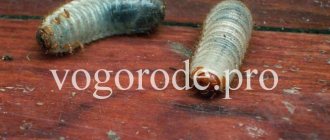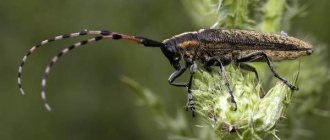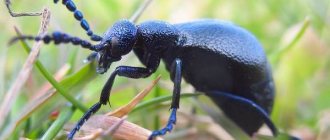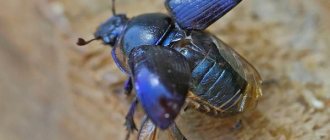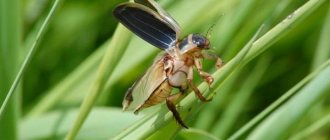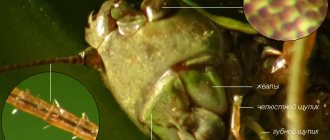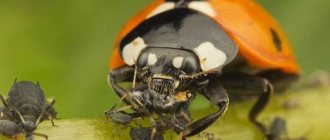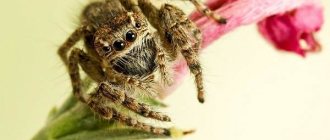The bronze beetle does not mean a specific species of insect, but rather a subfamily belonging to the family of lamellar beetles, of which there are more than 4,000 species. Most bronzebacks are inhabitants of the tropics. At least 33 species of these beetles live in Russia. The family includes not only bronze beetles, but also rhinoceros beetles. This family also includes one of the main agricultural pests – the cockchafer.
Types of bronzes
The beetles get their name from the metallic sheen of their shell. But beetles of this subfamily cannot always be identified at first glance. Some have a simple black shell without a hint of metallic sheen. The most recognizable is the golden bronze - the most widespread and numerous species in Eurasia. Some Eurasian species:
- golden;
- smooth;
- smelly;
- hairy;
- marble;
- copper.
Shamil's Bronzewort is a rare species, endemic to inland Dagestan.
Nutritional Features
The bronze beetle has a very refined taste.
It feeds on the flowers of not only wild, but also cultivated trees and shrubs. In addition, young shoots and leaves are of interest to him. It is not uncommon to find beetles inside juicy fruits. To be more specific, the golden bronze loves pears, rowan, maple, sage, sorrel, rye, and mustard. It must be said that the presented insect can gather in fairly large quantities precisely where tree sap flows to the surface. The golden bronze beetle is a voracious beetle. It causes a lot of harm to plants, but it is still not capable of completely destroying the crop.
General characteristics of beetles
The body is short. The rear line is almost straight. The transitions from the back to the sides are rounded. The head is small, directed down and forward. This family is called lamellar because of the special structure of the antennae, which, if necessary, the insect unfolds into a fan of plates.
Interesting!
The flight speed of bronze beetles is significantly higher than that of other flying beetles.
This success in bronzebacks is due to the special structure of the elytra: there are small cutouts on the sides between the abdomen and the rigid plate. Through them, insects release translucent brown wings. The elytra remain folded and do not slow down the bronco. Other beetles are forced to open their elytra, which stick out upward and to the sides during flight and greatly interfere with flight.
How to fix the problem naturally?
In order to deal with a pest, you need to use several methods to eliminate it.
If the number of beetles is small, then they can be collected manually. This method is considered as safe as possible for plants and the environment. Collecting insects is not difficult. They are clearly visible on the leaves due to their golden tint. It is enough to simply shake off the individuals sitting on the bushes into a bag. Then you can destroy them simply by crushing them with something heavy. If the beetles are high on the tree and cannot be removed manually, then you can simply lay out a film under the crown and shake the crown a couple of times. Simply collect fallen insects and drown them in water or crush them.
Light traps that are used only at night are also very effective. Making them is quite simple. An ordinary lamp is installed in an ordinary glass jar. Since insects usually fly towards the light, they hit the walls of the jar. Near it you need to place containers with kerosene. After the insect loses its orientation, it falls into this vessel and dies in it.
In addition, there are some species of birds that feed on these pests. Try to attract magpies, rooks or jackdaws to your garden. They will quickly deal with these insects.
Coloring
The color of bronzes is very diverse. These beetles are not always beautifully colored. Even within the same species and habitat, the color of bronzes can vary greatly.
On a note!
Sometimes the coloring is formed by special highlights that completely cover the main background. The color can be with or without a metallic sheen.
Bronze beetle
With a metallic sheen, that is, shiny, oily-shiny and matte-shiny:
- green with various shades is the most common in the group;
- blue;
- copper red;
- purple;
- purple;
- bronze;
- black with a metallic sheen.
Beetles without a metallic sheen may have the following colors:
- black;
- brown;
- brown;
- red in different shades;
- green;
- yellow;
- white with an olive or gray tint.
On a note!
All members of the family have a characteristic feature: light spots, shaped like the edges of scales.
The spots may be:
- yellowish;
- clay-yellow;
- white;
- pink.
They are located on the elytra, pronotum, underside of the abdomen and upper part of the hind legs. The spots can be of different sizes and shapes. Sometimes these markings merge, covering most of the beetle's body. Most often this happens on the elytra.
Habitat
It must be said that this pest lives over a vast territory of Europe and Asia.
Naturally, it can only live where there are plants suitable for food. That is, you will not find it in desert regions. To continue living, the beetle needs trees and bushes. Ideal living conditions are illuminated meadows and clearings. In places where there is a shortage of sunny color, pests are rare. In cold climates, a new generation of insects can develop up to 2 years.
Golden bronze
Another official name of the beetle is the common bronze beetle. It is sometimes called the green cockchafer. The name is completely incorrect, since these two species differ not only in color, but also in structure, as well as in the time of summer. If you compare the bronze beetle with the May beetle in the photo, photographing the insects from above and behind, you will see that the May beetle’s abdomen is much longer than the elytra and has a sharp rear tip. The elytra of the May's are ribbed and directed at a greater angle to the ground than those of the Bronze's.
The golden bronze beetle is a small beetle. Among Russian Coleoptera there are significantly larger specimens. But you can’t call her small either. The body length of the golden bronze is 13-23 mm, with a width of 8-12 mm.
Common bronze
On a note!
Golden bronze has many color variations. The only common feature: it is a beetle with a shiny metallic color. You can even find a blue beetle.
Color variations
Main color options:
- The upper part of the body is copper-purple with a metallic tint. The lower one is black with a purple sheen.
- Black without shine.
- A “regular” emerald beetle, but there are no scales on the back, only two spots.
- Iridescent beetle. The pronotum and head are emerald green with a golden tint. When lit from the side, the reflection is dark blue. The elytra are green. When illuminated from the side, they appear violet-brown. There are no white spots.
- The elytra, pronotum and head are green or golden-green. The beetle is covered with bristles.
- On the main background there are large and numerous white spots, which often merge into transverse wavy lines.
- The back and legs are golden-red or golden-green. There is a strong copper-red tint.
- Dark purple color. There are characteristic white spots on the elytra. There are no spots on the abdomen and pronotum.
- The top is copper-red or copper-brown, the bottom is bronze-green. Many spots on the elytra.
- The color on top is dark bronze or dark bronze-green. Bottom – black.
- The scutellum, pronotum and head are dark copper-red. The elytra are black and green. The lower part is black.
- Olive green color without blemishes.
- The upper side is dark purple with characteristic spots, the lower side is dark red with a strong purple sheen.
- The back is golden-green. May be copper-red.
- The upper part is green or golden green, the lower part is green.
- The top of the beetle is green, the back of the abdomen is purple-red, and the chest side is purple.
- The upperparts are golden-green or copper-red, without spots.
- Dark blue back with a green tint. There are white spots on the elytra.
- The back is bright blue, the chest is black-blue, blue-green, blue.
Bronzovka color
Bronzovkas are very “democratic” in their coloring. In addition to those listed, there are about a dozen different variations.
On a note!
Another pearlescent green beetle, the mint leaf beetle, is sometimes confused with the bronze beetle. This green bug is 2 times smaller than the bronze bug and has a convex shell shape. It eats the leaves of essential oil plants and causes much more harm than the bronze moth. But the leaf beetle belongs to a different family.
Lifestyle
Golden bronzes are distributed throughout the Eurasian continent. They are not found only in mountains and deserts. Bronzeworts eat flower cores. They have a wide menu and can damage the flowers of cultivated and wild plants. Very often they can be found on roses, where they climb into the very core. But bronzes are not capable of causing serious harm to the garden.
Interesting!
Gardeners do not like these insects, because they believe that the larva of the bronze beetle eats the roots of garden crops. In fact, plants are harmed by the larvae of the cockchafer, which are similar to the offspring of bronze beetles.
Bronzeworts are very light- and heat-loving creatures. They are active during the day in hot sunny weather. On cloudy days, bronzes are apathetic. They sit almost motionless on the cores of flowers and do not try to fly. In rainy and cold weather they hide in shelter:
- under rosettes of flowers;
- into the litter on the ground;
- under the roots of plants.
At night, beetles also descend to the ground.
The similarity between bronze beetles and May brown beetles is summer time. Bronzeworts are heat-loving and their lifespan depends on the climate in the region. In the northern regions, beetles only appear in June, while in the southern regions, the beetles begin in mid-May.
The development period of a beetle from egg to adult can take from several months to a year, depending on when the eggs were laid. If the insect has managed to develop to the adult stage by autumn, the adult overwinters in shelters and wakes up much earlier than the main summer time of this species.
What does the bronze beetle eat?
What makes the bronze beetle different from the cockchafer is its food supply. The cockchafer damages the leaves of bushes and trees. Bronzewort eats the core of flowers. The larva of the May beetle (Khrushchev) feeds on the roots of living plants. Bronzovki - rotting organic matter.
Bronze beetle nutrition
The insect eats flowers of plants from 31 families. The list includes Rosaceae, mulberry, umbelliferae, dogwood, ranunculaceae and many other families.
Larva
All larval stages of lamellar beetles are similar to each other. And the larvae of representatives of this subfamily are also so similar that it is often difficult to understand the types of insects not only from the description, but also from the photo. In order not to remember the signs that distinguish one C-shaped larva from another, gardeners prefer to fight all of them at once. Measures to combat the bronze beetle have not been developed, since it cannot cause serious harm to the crop. The years of these shiny green beetles begin after the fruit trees have bloomed. Flowers can be damaged only by individual individuals that emerge from hibernation earlier than the bulk of the bronzes.
On a note!
Some species of bronzefish in Russia are under state protection.
The larvae of these beetles process organic matter more than earthworms. As a result, the benefits from the larvae are greater than the harm from the imago. And given that three species are protected, it is easier to separate different types of larvae.
The differences between the larvae of the bronze beetle and the May beetle are clearly demonstrated by the table:
| Bronzovka | Khrushchev |
| Eats rotting organic matter | Eats living plant roots |
| Body covered with stubble | Body smooth |
| Paws short, non-functional | The paws are long, tenacious, allowing for rapid movement. |
| Body of the same diameter along the entire length | The body is strongly thickened in the caudal part |
| The head is small, inconspicuous compared to the diameter of the body | The head is huge compared to the bronze one. The diameter of the head is equal to the diameter of the body |
| Mandibles are small and weak | Powerful gnawing type mandibles |
At home, only those who are not afraid of worms and insects can figure out the larvae. The rest just kill everyone.
On a note!
You can save the future harvest by collecting adult bronzefish by hand.
Lifestyle
Bronze cats lead an active lifestyle during daylight hours, especially loving sunny, bright days. Then they fly from place to place, moving at an impressive speed for such massive insects. It happens that a bronze bird does not have time to go around an obstacle it encounters, crashes into it and falls to the ground with a dull thud.
A bronze whale that falls from the sky usually lands on its back and flounders in the dust for a long time before it manages to regain its former balance. But in most cases, bronzes are very maneuverable, and rarely lose face. The beetle spends energy sparingly; it tries to choose flowers and inflorescences on which it can linger longer in order to both rest and eat.
In cloudy weather, they try not to get out of their shelters, which are provided by the leaves and roots of plants. Overnight stays are also most often arranged on the ground. The bronzes spend the winter months there in the ground. In different areas of the range, the activity of bronzes varies. In some places the flight lasts 2.5 months, in others 4.5 months, depending on the number of hot days.
Smooth bronze
Very similar to one of the variants of the golden bronze beetle - the smooth bronze beetle, listed in the Red Book of the Moscow Region. This species prefers old forests and parks where there are many rotten trees.
Smooth bronze
Distributed in Southern Europe. In Russia in the north, the border of the range passes through Kaliningrad, Voronezh, and Samara. In the south - across the border with Ukraine to Orenburg.
This beetle with a green shiny back is larger than its “relative”. Its body length is up to 3 cm. There are no white markings on the elytra and cephalothorax. The elytra have either a golden or copper-red sheen. Legs and underside of body with a bluish tint.
Insect development cycle
So, as already mentioned, larvae emerge from the egg.
They have a fairly large body, curved in the shape of the letter “c”. It has yellow and white colors. The larva is covered with small hairs and has short legs. She feels great in a warm place where she can eat. That is, it can often be found in manure or rotten wood. Please note that before becoming a pupa, the larva sheds its skin several times. The second period of development occurs in the same area in which the larva lived. That is, this is where the pupa appears. It already has outlines similar to the image of an adult beetle. This period of insect development lasts relatively short, only 14 days.
The female can lay eggs at any time of the year. The duration of the full development cycle depends on this.
Marble
An analogue of the golden bronze with a green shell decorated with white markings. The marbled fish often has a greenish tint to its shell. The body size is slightly larger: up to 27 mm.
Distributed throughout Eurasia, except for the mountain forests of the Caucasus and Crimea. Prefers lowland forests. Settles on old trees. The species is numerous, but insects are found alone. These beetles are active from June to August in the European part of Russia and from mid-May to mid-August in Ukraine.
The life cycle in warm regions takes 1 year, in northern regions – 2 years. Females lay eggs in old stumps of some tree species.
Reproduction and lifespan
When it is time to mate depends on weather conditions. If they are favorable, the bronzes will mate and the female will lay 15-20 eggs. She does this in rotten stumps, compost heaps, and anthills. Bronze larvae develop from the eggs .
Over time, they build a cocoon around themselves, gluing together leaves and pieces of wood with their secretions. What gender the children will turn out to be depends on the ambient temperature. If it is too cold or hot, only males or only females will hatch from the cocoons. The insect fully matures only after 2-3 years.
Smelly
Other names: spotted deer or fetid deer. A small shiny black beetle. Body size up to 13 mm. There are many small white spots on the elytra. The body is covered with white dense bristles. Lives in warm regions, including southern Russia.
An agricultural pest, as the larvae eat plant roots. The adult feeds on pollen. Summer begins in May.
Types of bronzes
Food preferences
The harm this insect causes becomes clear from what the bronzeback eats.
Pest food preferences:
- flowers (especially light ones);
- young fruits;
- ovary of plants or fruits;
- first leaves.
The beetles completely eat up the stamens and pistils, so sexual reproduction of seed plants becomes impossible, and the yield sharply decreases. It is not surprising that gardeners and gardeners are looking for effective ways to deal with bronzes.
If the bronze fly gets into the house, then its food becomes indoor plants.
Looking for information
I was puzzled by the search for information upon returning to the city. In response to a photo of a beetle sent to relatives on Viber and the question “what kind of animal is this?” They answered me almost immediately: “black blister beetle” and sent me a link. I myself didn’t think of using photo search in Yandex or Google.
There is little information about this beetle on Wikipedia - only a few paragraphs. But the impetus for further search for information about the unusual creature was an article from this very resource. More precisely, a couple of sentences that completely captured the imagination, which I will specifically quote here:
“Young larvae of the common bluegill disperse over long distances, climbing onto flowers and attaching themselves to bees and other flying insects. To attract these insects, a group of larvae can themselves represent a flower bud.” Wikipedia
As a result, my attempts to learn a little more about the insect lasted for several evenings, during which I read several extensive articles about different types of T-shirt beetles and watched a popular science film that talked about them. But the more interesting the process was. Actually, below are the modest results of the research that I promised to share at the beginning.
How to protect the outside of your home with Clipper insecticide
Very good results are obtained if the new generation preparation Clipper is used for processing wooden structures. But it is effective to use only for protecting the external walls of the house; it is not suitable for indoor treatment.
The chemical insecticide Clipper (produced by ZAO FMRus) destroys and repels longhorned beetles, and also affects their reproductive system and inhibits the development of laid eggs. The drug has a contact and intestinal effect on beetles and their larvae.
Once in the body of the larva, the drug causes disruption of metabolic processes and paralysis, leading to the death of the pest. A beetle, sitting on the treated surface and coming into contact with the preparation, will die without laying a new egg.
The drug is recommended for use on lumber and the external surface of a wooden house. Treatment of dry wood should be done with a solution prepared strictly in accordance with the instructions, in dry cloudy weather, avoiding direct sunlight.
Its economical use, high efficiency and fairly low toxicity have been proven. However, it is a pesticide and its use requires compliance with special safety rules. Therefore, it is better to entrust the processing to specialists.
XILIX® Gel fungicide and insecticide in one bottle with a 10-year guarantee!
XILIX® Gel is an innovative development for combating any wood pests such as longhorned beetles, borers, shashel, wood borers, etc. It is also an effective professional biocide that effectively destroys mold, mildew, and copes with wood rot and defects.
Indispensable for the prevention and treatment of wooden structures.
• Destroys termites, borer beetles, bark beetles, wood borers, longhorned beetles, etc. • Economical and easy to use • Safe for people • Strengthens the structure of the wood • Ready to use, the gel does not flow, leaves no traces • Penetrates deeply into the wood
XILIX® Gel is an excellent, safe alternative to phosphine gas fumigation with a 10 YEAR warranty! High efficiency is achieved thanks to properly selected gel components. Biocides and permethrin in the composition give a fantastic insecticidal and fungicidal effect.
Thanks to its thixotropic formulation, the gel works without loss of properties even in a thick layer of wood, thereby reducing the number of applications to obtain the required therapeutic or prophylactic dose of the gel.
